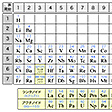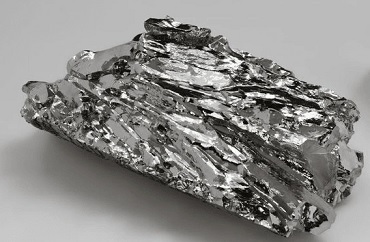ロジウム 化学特性,用途語,生産方法
外観
灰色の粉末
性質
白金族元素の一。単体は銀白色の金属。展延性に富む。白金との合金は耐食・耐熱性にすぐれ、熱電対つい・るつぼなどに使用。名は、塩の多くがバラ(ローズ)色をしていることにちなむ。元素記号Rh 原子番号45。原子量102.9。電子配置=[Kr]4d85s1おもな酸化数=I,II,III,IV周期表第VIII族に属する白金族元素の一つ。1804年W.H.ウォラストンが粗製白金を王水に溶かし,白金とパラジウムを除去した溶液から新しい金属を含む塩ヘキサクロロロジウム(III)酸ナトリウムNa3[RhCl6]を得,塩の水溶液がばら色であったのでギリシア語rhodon(バラ)にちなんで命名した。
溶解性
熱硫酸及び熱王水に溶ける。
解説
ロジウムは,周期表第9族に属し、白金族元素の一つ。1804年、イギリスのウォラストンは白金鉱の中から新しい金属元素を単離したが、その塩類の多くがバラ色をしていることから、ギリシア語のバラ色rodeosにちなんでロジウムと命名した。白金鉱およびイリドスミン中に含まれ、ときには金と自然合金をつくって産出する。 ニッケル、銅の電解精錬の際に得られる陽極泥や白金鉱を王水処理してほかの金属を除き、塩化ロジウムとすると、ロジウムはスルファト錯体として溶液中に抽出される。これをヘキサクロロロジウム(Ⅲ)酸アンモニウム(NH4)3[RhCl6]に変え、精製したのち、水素中で熱還元すれば海綿状のロジウムが得られる。 銀白色の軟らかい金属で延性がある。その化合物を適当な還元剤で処理して得られたものは黒色の粉末で、ロジウム黒(こく)といわれる。化学的性質は周期表直下のイリジウムに似ており、酸に対してはきわめて抵抗力が大きく、酸素に対しては比較的弱い。すなわち塊状のものはどんな酸にも溶けず、王水にも侵されない。しかし酸化力の強い熱濃硫酸や塩素酸ナトリウムを含む熱濃塩酸(封管中125~150℃)には溶ける。粉末状のものはより活性である。空気中、常温では酸化されないが、強熱するとしだいに酸化されて酸化ロジウム(Ⅲ)Rh2O3を生じ、これはさらに強熱すると分解して酸素を放出する。白金の硬化元素として使われるが、白金‐ロジウム合金は耐食性、耐熱性に優れている。そのほか各種触媒、熱電対などの用途がある。[鳥居泰男][補完資料] | ロジウム(データノート)  "周期表
"周期表
小学館 日本大百科全書(ニッポニカ) )
解説
Rh.原子番号45の元素.電子配置[Kr]4d85s1の周期表9族貴金属または白金族元素.原子量102.90550(2).安定核種が質量数103の同位体のみの単核種元素.質量数89~122の放射性同位体が知られている.1804年,イギリスのW.H. Wollastonが粗白金試料中に発見,塩化物RhCl3の赤色から,ギリシア語の“バラ色”ροδον(rodon)をとって命名.宇田川榕菴は天保8年(1837年)出版の「舎密開宗」巻十五で,新金属として羅冑母(ロヂウム)と記載している.地殻中の存在度の低い白金族中でもきわめて存在度が低く ppb 以下とされる.世界の知られている埋蔵量の約90% を南アフリカが占め,ついでロシア,カナダの順である.単体は立方最密構造の銀白色の金属.白金族精鉱から溶媒抽出法で相互分離し,(NH4)3RhCl6としてとりだし,水素還元して金属を得る.融点1966 ℃,沸点3695 ℃.密度12.41 g cm-3.第一イオン化エネルギー7.46 eV.酸化数1~4,通常3.化学的にきわめて安定で,二元化合物の数は少ないが錯体は多数存在する.酸化して600 ℃ 以上で酸素と反応してRh2O3となるが,1200 ℃ 以上で分解してRhに戻る.塩素とも300 ℃ で反応してRhⅢ Cl3となるが,318 ℃ で逆反応を起こしてRhとなる.塊は王水にも不溶.熱硫酸に可溶.自動車排気ガス浄化用3元触媒のNOx還元用成分として不可欠で,わが国の需要の80% を占める.ついで液晶ディスプレイ用高級ガラス製造用るつぼ材のPt-Rh合金原料として10%,ほか化学工業用触媒に用いられる.2005年には,わが国は全輸入量9.5 t 中,6.5 t を南アフリカ,0.8 t をアメリカ,0.7 t をロシアから輸入した.
用途
高純度金属、白金硬化材、合金材料、電気部品材料、蒸着材。
用途
用途としては排ガス制御の触媒として重要。また、めっき(ロジウムめっき)にも使われ、 特に銀やプラチナ、ホワイトゴールドなどの銀白色の貴金属製装身具の着色、保護用に 多用される。プラチナとの合金は、るつぼや熱電対に利用される
用途
触媒。
構造
ロジウムは高温で酸化され、酸化数は-1価から+6価まで取ります。常温常圧でロジウムの安定な結晶構造は、面心立方構造です。ただし、1,000℃以上に熱すると、単純立方格子に変化します。
使用上の注意
純度は金属ベースで差数法によって算出したもので、重量又は容量分析等の化学的方法によるものではありません。使用目的により、正確な含量が必要な場合は、それらの方法によって測定する必要があります。
説明
Rhodium is one of the platinum group elements, and is found
at very low concentrations in the Earths crust. Rhodium was
discovered by William Hyde Wollaston (England) in 1804. The
origin of the name comes from the Greek word rhodon,
meaning rose. The plated solid is very corrosion resistant and
exceptionally hard. While inert in air and acids, it can produce
a violent reaction to chlorine, bromine pentafluoride, bromine
trifluoride, and fluorine monoxide.
化学的特性
Rhodium, together with platinum, palladium, iridium, ruthenium, and osmium, is one of the platinum-group metals in Group VIII of the Periodic Table. Rhodium metal is a white, hard, ductile, malleable solid with a bluish-gray luster. soluble in ether, alcohol, and water. The alloys of rhodium can also be used in high temperature conditions (i.e., thermocouples and crucibles). It also can be used in electroplating glass products due to its reflective properties.

物理的性質
Rhodium is a hard shiny-white metal that resists corrosion from oxygen, moisture, andacids at room temperatures. As a member of group 8 (VIII),
45Rh shares many chemical andphysical properties with cobalt (
27Co) just above it and iridium (
77Ir) below it in the verticalgroup. Therefore, it is considered one of the elements that are transitory between metals andnonmetals. It is rare and only found in combination with platinum ores.
Rhodium’s melting point is 1,966°C, its boiling point is 3,727°C, and its density is 12.41g/cm
3.
同位体
There are 52 isotopes of rhodium, ranging from Rh-89 to Rh-122. All are producedartificially with relatively short half-lives except one stable isotope, Rh-103, whichconstitutes 100% of the element’s existence in the Earth’s crust.
名前の由来
Named after the Greek word rhodon, which means “rose,” because of
the reddish color of its salt compounds.
天然物の起源
Rhodium is rare, but not as rare as ruthenium. It makes up only 1 part in 20 million of theelements found in the Earth’s crust. Even so, it is considered the 79th most abundant elementand is found mixed with platinum ore, and to a lesser extent, it is found with copper andnickel ores. It is found in Siberia, South Africa, and Ontario, Canada.
Rhodium is recovered from platinum and other ores by refining and purification processesthat start by dissolving the other platinum group metals and related impurities with strongacids that do not affect the rhodium itself. Any remaining platinum group elements areremoved by oxidation and bathing the mixture in chlorine and ammonia.
Rhodium is usually produced as a powder and can be formed by either casting or powdermetallurgy.
特性
Rhodium is one of the six platinum transition elements that include Ru, Rh, Pd, Os, Ir, andPt. Of these metals, rhodium has the highest electrical and thermal conductivity. Although arelatively scarce metal, rhodium makes an excellent electroplated surface that is hard, wearswell, and is permanently bright—ideal for plating the reflectors in automobile headlights.
来歴
Wollaston discovered rhodium in 1803-4 in crude
platinum ore he presumably obtained from South America.
Rhodium occurs native with other platinum metals in river
sands of the Urals and in North and South America. It is also
found with other platinum metals in the copper-nickel sulfide
ores of the Sudbury, Ontario region. Although the quantity
occurring here is very small, the large tonnages of nickel processed
make the recovery commercially feasible. The annual
world production of rhodium in 1999 was only about 9000
kg. The metal is silvery white and at red heat slowly changes
in air to the sesquioxide. At higher temperatures it converts
back to the element. Rhodium has a higher melting point
and lower density than platinum. Its major use is as an alloying
agent to harden platinum and palladium. Such alloys are
used for furnace windings, thermocouple elements, bushings
for glass fiber production, electrodes for aircraft spark plugs,
and laboratory crucibles. It is useful as an electrical contact
material as it has a low electrical resistance, a low and stable
contact resistance, and is highly resistant to corrosion. Plated
rhodium, produced by electroplating or evaporation, is exceptionally
hard and is used for optical instruments. It has a high
reflectance and is hard and durable. Rhodium is also used for
jewelry, for decoration, and as a catalyst. Fifty-two and isomers are now known. Rhodium metal (powder) costs
about $180/g (99.9%).isotopes
使用
Rhodium is a transition metal catalyst used in a multitude of inorganic synthesis.
定義
A rare silvery hard
transition metal. It is difficult to work and
highly resistant to corrosion. Rhodium occurs
native but most is obtained from copper
and nickel ores. It is used in protective
finishes, alloys, and as a catalyst.
Symbol: Rh; m.p. 1966°C; b.p. 3730°C;
r.d. 12.41 (20°C); p.n. 45; r.a.m.
102.90550.
調製方法
Pure rhodium is prepared by the reduction of its ammonium
salt (dichloropentaaminorhodium).
一般的な説明
This product has been enhanced for energy efficiency.
危険性
The powder and dust of rhodium metal are flammable in air. Some of the compounds maycause skin irritations. It is best to use approved laboratory procedures when handling any ofthe six elements in the platinum family of metals.
健康ハザード
There are no data demonstrating
acute or chronic rhodium-related diseases;
irritation and sensitization have occasionally
been reported in humans from exposure to the
salts of rhodium. Solutions of insoluble salts
splashed in the eye may cause mild irritation.
産出
ロジウムは白金鉱石から、ウィリアム・ウォラストン (英: William Hyde Wollaston) により発見されました。現在でもロジウムは、不純物として白金鉱石から産出されています。
使用用途
ロジウムは、装飾品の着色や強化のため、メッキとして使用されています。また、硬度や耐食性の高さ・電気抵抗の低さから、コンピューターのにも利用されています。その他にもロジウムは、反射鏡や熱電対、干渉フィルタ、ガラス繊維製造用ノズルなど、さまざまな分野で幅広く使用可能です。
ロジウムは、自動車の排気ガス中に含まれる有害物質である窒素酸化物を窒素に変える働きがあることから、自動車排気ガスの有害性を弱めるための三元触媒 (英: three-way catalyst) としても使われています。また、オキソアルコールやを生産する反応過程でも、ロジウムを触媒として用いることが可能です。
同位体
1. ロジウムの同位体
ロジウムの原子量は、102.90550です。ロジウムの同位体の中で、103Rhが最も安定しています。放射性同位体のうち最も安定なものは101Rhであり、半減期は3.3年です。それ以外の比較的安定な同位体には、半減期が207日の102Rh、半減期が2.9年の102mRh、半減期が16.1日の99Rhなどがあります。
その他20種類の放射性同位体が存在し、原子量は92.926から116.925までを取っています。そして半減期が20.8時間の100Rhや半減期が35.36時間の105Rhを除くと、ほとんどの半減期は1時間以下です。
ロジウムには核異性体も多数存在し、安定な例として102mRhや101mRhが挙げられます。102mRhの励起エネルギーは0.141MeV、半減期は207日であり、101mRhの励起エネルギーは0.157MeV、半減期は4.34日です。
2. ロジウムの同位体の崩壊
最も安定である103Rhより軽い同位体は、電子捕獲 (英: electron capture) によってに崩壊します。それに対して103Rhより重い同位体は、ベータ崩壊 (英: beta decay) によってパラジウムに崩壊します。
工業用途
Metallic rhodium is the whitest of the platinum metals and does not tarnish under atmospheric conditions. It is insoluble in most acids, including aqua regia, but is attacked by chlorine at elevated temperatures and by hot fuming sulfuric acid. Liquid rhodium dissolves oxygen, and ingots are made by argon-arc melting. At temperatures above 1200 C, rhodium reacts with oxygen to form rhodium oxide, Rh2O3. Rhodium is used to make the nibs of writing pens, to make resistance windings in high-temperature furnaces, for high-temperature thermocouples, as a catalyst, and for laboratory dishes. It is the hardest of the platinum-group metals; the annealed metal has a Brinell hardness of 135. Rhodium is also valued for electroplating jewelry, electric contacts, hospital and surgical instruments, and especially reflectors.
The most important alloys of rhodium are rhodium platinum. They form solid solutions in any proportion, but alloys of more than 40% rhodium are rare. Rhodium is not a potent hardener of platinum but increases its high-temperature strength. It is easily workable and does not tarnish or oxidize at high temperatures. These alloys are used for thermocouples and in the glass industry.
安全性プロファイル
Handle carefully. It may be a sensitizer but not to the same extent as platinum. Most rholum compounds have only moderate toxicity by ingestion. Flammable when exposed to heat or flame. Violent reaction with chlorine, bromine pentafluoride, bromine trifluoride, and OF2. A catalytic metal
職業ばく露
Rhodium has few applications by
itself, as in rhodium plating of white gold jewelry or plat-
ing of electrical parts, such as commutator slip rings, but,
mainly, rhodium is used as a component of platinum alloys.
Rhodium-containing catalysts have been proposed for use
in automotive catalytic converters for exhaust gas cleanup.
発がん性
Chick embryos exposed to rhodium on the
eighth day of incubation were stunted; mild
reduction of limb size and feather growth inhibition
were also observed. A number of
rhodium compounds have tested positive in
bacterial assays for genetic altering capability.
環境運命予測
The most common route by which rhodium enters the environment
is as a component of automobile exhaust resulting
from use of catalytic converters. Rhodium is insoluble in water
and all acids, with the exception that very finely separated
material may be dissolved in concentrated sulfuric acid and
aqua regia.
Being largely inert, rhodium can undergo long-range
transport, and particulate phase matter generally leaves the
atmosphere by wet or dry deposition. In an aqueous environment,
rhodium can form complexes with halide and
nitrogen donor ligands, which may be water soluble, but
reactions can be dictated by pH, redox potential, and what
material is available for creating ligands. Reactions in soil can
depend on these same factors, as well as chloride concentrations, and rhodium is seen to be mobile only in
highly acidic soils.
Rhodium has been seen to bioaccumulate in both fresh and
salt water species, and has the potential to biomagnify.
輸送方法
Flammable powder, Hazard Class: 4.1; Labels:
4.1-Flammable solid.
不和合性
Flammable as a dust, fume, or powder
may form explosive mixture with air. Incompatible with
strong oxidizers (chlorates, nitrates, peroxides, permanga-
nates, perchlorates, chlorine, bromine, fluorine, etc.); con-
tact may cause fires or explosions. Keep away from
alkaline materials, strong bases, strong acids, oxoacids,
epoxides, bromine pentafluoride, and bromine trifluoride;
chlorine trifluoride; oxygen difluoride.
廃棄物の処理
Recovery in view of the high
economic value. Recovery techniques for recycling of
rhodium in plating wastes and spent catalysts have been
described in the literature.
ロジウム 上流と下流の製品情報
原材料
準備製品